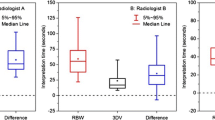Abstract
Three-dimensional (3D) computed tomographic (CT) reconstructions were studied retrospectively in 14 patients with skull base fractures. Our aim was to assess the clarity of visualisation and pattern of these fractures. The reformations were obtained from 3 mm thick two-dimensional (2D) CT images. The 2D data stored on optical discs were retrieved and reformatted using the scanner's software. The 3D technique could demonstrate the presence of fractures as well as 2D images. It was of special value in defining the depth and extent of fractures in the floor of the cranial fossae. Undisplaced and displaced fractures could both be demonstrated. Fractures in the anterior fossa run diagonally towards the midline and then cross the cribriform plate of the ethmoid bone. Fractures of the middle fossa run obliquely anteroposterior. Fractures in the lamina papyracea and cribriform plate were difficult to reconstruct due to the the thinness of these bones and threshold definitions. The volume of the 3D block determines the angles suitable for viewing the fractures. In spite of present technical difficulties, the 3D images are of greater anatomical and diagnostic value, particularly in anterior fossa fractures. There is no additional radiation risk to the patient, since reconstructions are made from routine 2D images.
Similar content being viewed by others
Literatur
Hemmy DC, Tessier PL (1985) CT of dry skulls with craniofacial deformities: accuracy of three-dimensional reconstruction. Radiology 157: 113–116
Dolan WC, Young P, Vassiliadis A (1988) Threëdimensional computed tomography for maxillofacial surgery: report of cases. J Oral Maxillofac Surg 46: 142–147
Pilgrim TK, Vannier MW, Hildbolt CF, March JL, McAllister WH, Shackelford GD, Offutt CJ, Knapp RH (1989) Craniosynostosis: image quality, confidence and correctness in diagnosis. Radiology 173: 675–679
Uhrmeister P, Langer M, Zwicker C, Astinet F, Felix R (1991) Dreidimensionale Computertomographic von Frakturen. Akt Traumatol 21: 675–679
Vannier MW, March JL, Warren JO (1984) Three-dimensional CT reconstruction images for craniofacial surgical planning and evaluation. Radiology 150: 179–186
Zonneveld FW, Lobgret S, Jaques C, van der Meulen TC (1989) Three-dimensional imaging in craniofacial surgery. World J Surg 13: 328–342
Gillespie JE, Adams JE, Isherwood I (1987) Three-dimensional computed tomographic reformations of sellar and parasellar lesions. Neuroradiology 29: 30–35
Howard JD, Elster AD, May JS (1990) Temporal bone: three-dimensional CT. Part I. Normal anatomy, technique and limitations. Radiology 177:421–425
Ali QM, Ulrich C, Becker H (1993) Three-dimensional CT of the middle ear and adjacent structures. Neuroradiology 35: 238–241
Howard JD, Elster AD, May JS (1990) Temporal bone: three-dimensional CT. Part II. Pathologic alterations. Radiology 177: 427–430
Zonneveld FW, van Overbeeke JJ, Vaandrager JM, van Veelen CW, van der Meulen JC, Tulleken CAF (1992) Three-dimensional CT of skull base. Proc First International Skull Base Congress, pp 34–35
Grodd W, Dannenmaier B, Peterson D, Gehrke G (1987) Dreidimensionale (3D) Bildrekonstruktion von Gesichtsschädel und Schädelbasis in der Computertomographie. Radiologe 27: 502–510
Macpherson P, Teasdale E (1989) Can computed tomography by relied upon to detect skull fractures? Clin Radiol 40: 22–24
Author information
Authors and Affiliations
Rights and permissions
About this article
Cite this article
Ali, Q.M., Dietrich, B. & Becker, H. Patterns of skull base fracture: a three-dimensional computed tomographic study. Neuroradiology 36, 622–624 (1994). https://doi.org/10.1007/BF00600424
Received:
Accepted:
Issue Date:
DOI: https://doi.org/10.1007/BF00600424




